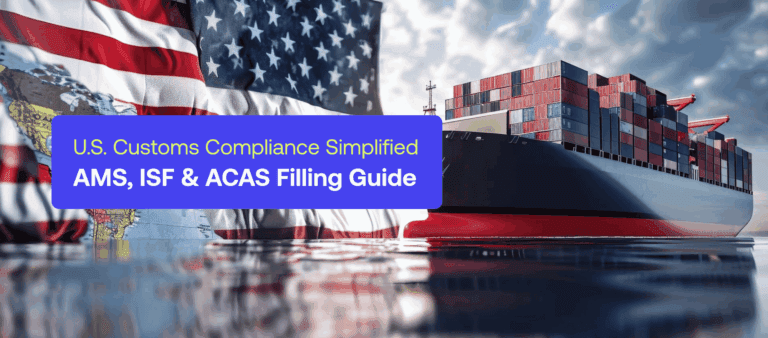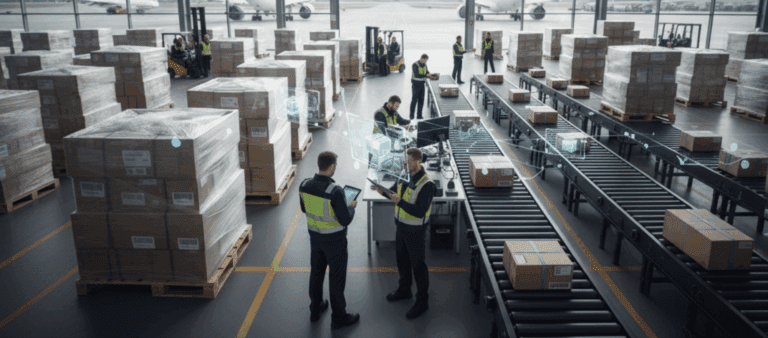U.S. Customs Compliance Simplified: AMS, ISF & ACAS Filling Guide
- John Hall
- Customs Specialist at iCustoms.ai
Trading in the United States is no easy task, and competency and adherence are essential. For any business importing goods into the United States, the margin between profit and loss can always be determined by the smooth movement of the cargo through the United States customs and border protection (CBP).The critical tools for ensuring this seamless flow are three federally mandated systems: the Automated Manifest System (AMS), the Importer Security Filing (ISF), and the Air Cargo Advanced Screening (ACAS) program.
This customs import compliance guide covers all essential filing systems, providing you with the knowledge needed to maintain compliance while optimizing your trade operations. Whether you’re new to international trade or looking to refine your existing processes, understanding these three critical systems will help you navigate the regulatory landscape with confidence.
Understanding the Core of the U.S. Customs Compliance: AMS, ISF & ACAS
The foundation of successful US customs compliance lies in accurate and timely filing across three primary systems maintained by the U.S. Customs and Border Protection (CBP). Each system serves a specific purpose while working together to create a comprehensive security and compliance framework.
The Automated Manifest System (AMS) handles advanced cargo information for both ocean and air shipments. The Importer Security Filing (ISF) system, commonly known as “10+2,” focuses specifically on ocean cargo security data. Air Cargo Advance Screening (ACAS) addresses the unique security requirements for air freight shipments.
Understanding how these systems interact is crucial for maintaining compliance. While each has distinct requirements and deadlines, they often share common data elements and work together to provide CBP with the information needed to assess cargo risk before arrival in the United States.
The penalties for non-compliance can be substantial, with violations potentially costing thousands of dollars per incident. More importantly, compliance failures can result in cargo delays, increased scrutiny from CBP, and damage to your company’s reputation as a trusted trader.
1. Automated Manifest System (AMS): Your First Line of Compliance
1.1 AMS Filing Requirements and Deadlines
The Automated Manifest System serves as the primary platform for submitting advance cargo information to CBP. For ocean freight, carriers must file AMS data 24 hours before departure from the foreign port. Air cargo requires filing 4 hours before arrival in the United States.
These deadlines are non-negotiable and strictly enforced. The 24-hour rule for ocean freight was implemented as part of the Container Security Initiative, designed to provide CBP with sufficient time to analyze cargo risk and take appropriate action if necessary. Similarly, the 4-hour air cargo requirement balances security needs with the speed requirements of air transportation.
Filing deadlines for us customs compliance must account for weekends and holidays, as CBP systems operate continuously. Many experienced importers submit their AMS filings well ahead of the minimum requirements to allow time for corrections if CBP identifies any issues with the submitted data.
1.2 AMS Purpose and Functionality
AMS filings require detailed information about the shipment, including complete shipper and consignee details with IRS or EIN numbers. Commodity descriptions must be specific and accurate, avoiding vague terms like “general merchandise” or “various goods.” Each item requires proper Harmonised System (HS) codes, accurate weights, dimensions, and declared values.
Transportation details are equally important, including container numbers, seal numbers, and vessel or flight information. For consolidated shipments, the filing must include information about each individual shipment within the consolidation.
The quality of AMS data directly impacts cargo clearance speed. Incomplete or inaccurate information can trigger CBP examinations, resulting in delays and additional costs. Investing in data quality controls and validation processes pays dividends in smoother cargo flow and reduced compliance risks.
1.3 AMS Filing Requirements and Integration
Successful AMS filing requires coordination between multiple parties, including shippers, freight forwarders, and carriers. Establishing clear communication protocols ensures that all parties have access to accurate information within the required timeframes.
Many companies use AMS-compatible software platforms that integrate with their existing logistics systems. These platforms can automate data validation, flag potential issues before submission, and maintain detailed audit trails for compliance purposes.
Regular monitoring of AMS filing status is essential. CBP may request additional information or corrections, and prompt response to these requests helps prevent delays. Maintaining detailed records of all AMS filings and related correspondence supports both operational efficiency and compliance audits.
2. Importer Security Filing (ISF) - The "10+2" Rule
2.1 Understanding the ISF and the "10+2" Requirement
The landscape of U.S. import security was forever changed on January 26, 2009. This was the day the Importer Security Filing (ISF), more commonly known as the “10+2 Rule,” became fully enforced. This wasn’t a gentle suggestion; it was a fundamental shift, placing a new level of responsibility directly on importers to provide a detailed digital blueprint of their shipments long before they set sail.
Understanding these requirements isn’t just about checking boxes—it’s about preventing costly compliance violations that can reach a staggering $5,000 per mistake. The rule’s name breaks down the responsibility clearly: ten data elements fall to the importer, while two are the domain of the ocean carrier.
Meeting ISF filing requirements involves submitting 10 importer elements and 2 carrier elements for ocean shipments. The 10 importer elements include:
- Buyer
- Seller
- Importer of Record Number
- Consignee Number
- Consolidator
- Container Stuffing Location
- Commodity HTSUS Number (6-digit level)
- Country of Origin
- Supplier or Manufacturer
- Ship to Party
2.2 Responsibility and Timelines
- Who Files: The ISF Importer (owner of the goods, consignee, purchaser, or their customs broker/agent). For transit cargo (FROB), the carrier is the ISF Importer.
- When to File: Must be filed electronically to CBP 24 hours before the cargo is loaded onto the vessel for containerised cargo.
- Filing Methods: Can be submitted via the AMS or ABI (Automated Broker Interface).
- The ISF (5) Subset: For transit, FROB, T&E, or IE bonds, only five (5) data elements are required.
2.3 ISF Flexible Filing and Unified Options
- Flexible Options:
- Flexible Range (FR): Allows submission of best-known data for four elements (Manufacturer, Ship-to Party, Country of Origin, HTS), which must be updated later.
- Flexible Timing (FT): Allows delayed submission of Consolidator and Stuffing Location information.
- Flexible Range & Flexible Timing (FX): A combination of both options.
- Unified Filing: Allows certain elements (Importer of Record, HTSUS, Country of Origin, Consignee Number) to be reused for both ISF and entry summary (CBP Forms 7501/3461) if submitted by the deadline.
2.4 Common ISF Challenges
One of the most common challenges in ISF compliance is obtaining accurate manufacturer information, particularly for goods sourced through trading companies or complex supply chains. Establishing clear contractual requirements with suppliers helps ensure that necessary information is available when needed.
Container stuffing location information can be particularly challenging for consolidated shipments or goods that are packed at multiple locations. Working with experienced freight forwarders who understand ISF requirements can help navigate these complexities.
Regular US customs compliance training keeps staff updated on ISF requirements and helps prevent common filing errors. Training should cover not just the technical requirements but also the business processes needed to collect and validate ISF data within the required timeframes.
3. Air Cargo Advance Screening (ACAS): Securing Air Freight
3.1 ACAS Requirements and Data Elements
Air Cargo Advance Screening requires specific data elements for all air cargo shipments entering the United States on June 12, 2018. Required information includes complete shipper and consignee details, detailed cargo descriptions, total quantity based on the smallest external packing unit, total weight, and air waybill numbers.
The cargo description requirements for ACAS are particularly stringent, requiring specific details about the nature of the goods being shipped. Generic descriptions are not acceptable and can result in “Do Not Load” (DNL) orders that prevent cargo from being loaded onto aircraft bound for the United States.
ACAS data must be submitted prior to loading cargo onto the aircraft, giving CBP the opportunity to screen shipments before they depart for the United States. This advance screening capability is crucial for air cargo security, given the speed of air transportation and the limited opportunity for intervention once cargo is airborne.
3.2 ACAS Compliance Procedures
Successful ACAS compliance hinges on a tightly coordinated effort between all parties involved in the air cargo shipment. Each entity has distinct responsibilities for data collection, validation, and submission, all bound by strict CBP timeframes.
- Shared Responsibility Model: While air carriers hold the ultimate responsibility for submitting ACAS data to CBP, they are entirely dependent on shippers and freight forwarders providing accurate and timely information at the point of booking or before loading.
- Establishing Clear Data Protocols: Implementing robust data-sharing agreements and validation procedures is crucial. This ensures all parties—shipper, forwarder, and carrier—have access to the same accurate information precisely when needed, preventing last-minute errors and transmission failures.
- Investment in Specialised Training: Proactive investment in U.S. customs compliance training that specifically covers ACAS requirements is fundamental. Effective training programs must extend beyond the technical rules to include practical, role-based procedures for data collection and validation, empowering staff to execute their duties correctly and confidently.
3.3 Managing ACAS Compliance Risks
Effectively managing ACAS compliance risks is critical to maintaining the fluidity of your air cargo operations. Proactive strategies are essential to mitigate the unique and immediate consequences of non-compliance.
- Understanding the DNL Threat: The primary risk of ACAS non-compliance is not a monetary fine, but a “Do Not Load” (DNL) order from CBP. A DNL order prevents your cargo from being boarded the aircraft, causing immediate and significant logistical disruptions, costly delays, and potential harm to customer relationships.
- Developing Proactive Contingency Plans: To minimise operational impact, develop clear contingency procedures for potential ACAS issues. A key strategy includes maintaining strong relationships with multiple carriers and freight forwarders. This provides vital alternative routing options if a primary partner is unable to resolve a DNL situation in time.
- Implementing Continuous Performance Monitoring: A proactive risk management program requires regular monitoring of ACAS compliance performance. By systematically tracking key metrics such as DNL rates, data quality scores, and filing timeliness, you can identify negative trends and address potential issues before they escalate into major supply chain disruptions. This data-driven approach provides the foundation for continuous improvement and operational resilience.
Key Differences Between AMS, ISF, and ACAS
4. How AMS, ISF, and ACAS Systems Work Together
While AMS, ISF, and ACAS are separate systems with distinct requirements, they share common data elements and work together to provide CBP with comprehensive cargo information. Understanding these relationships helps streamline compliance processes and reduce the risk of inconsistencies between filings.
Many data elements required for ISF are also needed for AMS filings, creating opportunities for data sharing and validation across systems. Similarly, ACAS requirements often overlap with AMS air cargo requirements, allowing for integrated filing procedures.
Effective integration requires careful attention to data consistency across all systems. Discrepancies between AMS and ISF filings, for example, can trigger CBP scrutiny and potential examinations. Implementing data validation procedures that check for consistency across all required filings helps prevent these issues.
4.1 Compliance Strategies and Technology
Streamlined US customs compliance filing processes reduce operational risks and costs while improving supply chain visibility. Many companies invest in integrated compliance platforms that manage all three systems from a single interface, reducing the complexity of multi-system compliance.
Technology solutions can automate many aspects of compliance filing, including data validation, deadline monitoring, and status tracking. However, technology is only as good as the processes and data quality controls that support it. Successful compliance programs combine technology solutions with robust business processes and staff training.
Regular compliance audits help identify areas for improvement and ensure that procedures remain effective as business requirements change. These audits should cover not just filing accuracy but also process efficiency, staff training effectiveness, and technology performance.
4.2 Building Effective Compliance Teams
Successful US trade compliance requires dedicated staff with specialised knowledge of regulatory requirements and business processes. Building effective compliance teams involves not just hiring qualified personnel but also providing ongoing training and development opportunities.
Cross-training staff on multiple systems helps ensure continuity of operations and provides flexibility to handle varying workloads. Staff should understand not just the technical requirements of each system but also how they fit together to support overall compliance objectives.
Regular US customs compliance training programs should cover regulatory updates, process improvements, and lessons learned from compliance issues. Training should be practical and hands-on, giving staff the opportunity to practice procedures and ask questions about specific scenarios they encounter in their daily work.
5. Future Developments and Regulatory Changes of US
CBP is implementing an automated manifest rejection system scheduled for September 27, 2025, that will automatically reject filings with insufficient data. This system will introduce stricter validation requirements and enhanced quality control measures that will impact all three filing systems.
The new system will reduce CBP’s tolerance for incomplete or inaccurate filings, making data quality even more critical for successful compliance. Companies should begin preparing now by reviewing their data quality controls and validation procedures to ensure they meet the enhanced requirements.
These changes represent CBP’s continued evolution toward more automated, risk-based processing systems. Companies that invest in robust compliance procedures and data quality controls will be better positioned to adapt to these changes and maintain efficient cargo flow.
6. Why Going It Alone Might Be the Riskiest Path
So, the question becomes: are these complex filings consuming your team’s time and causing sleepless nights? Managing AMS, ISF, and ACAS in-house requires constant vigilance, specialised software, and deep regulatory knowledge. This is where partnering with an expert becomes a strategic business decision, not just an outsourcing task.
A professional filing service acts as your designated agent, taking full responsibility for accurate and timely data transmission to CBP. They manage the entire lifecycle of your filing, from the initial submission to handling arrival messages and any exceptions that arise. The benefits are immediate and profound. You avoid costly penalties and cargo delays, free up your logistics team to focus on core business activities, and gain the peace of mind that comes from leveraging professional-grade technology and expertise.
6.1 Empowering Your AMS, ISF, and ACAS Compliance with iCustom
In the complex landscape of U.S. import regulations, navigating AMS, ISF, and ACAS requirements can feel like a high-stakes balancing act. iCustoms transforms this complexity into competitive advantage by serving as your dedicated compliance partner.
Our platform goes beyond simple data processing—we bring deep regulatory intelligence that understands the intent behind CBP’s requirements, allowing us to anticipate potential issues and ensure your filings aren’t just submitted, but optimised for swift approval. Our AI-powered solutions ensure your AMS, ISF, and ACAS filings are accurate, timely, and compliant:
- AI-Powered Data Automation (IDP) Provides flexible intake methods, allowing you to submit documents via email, API integration, or simply bulk upload using drag-and-drop.
- Universal Format Acceptance: Our system processes documents in any format including PDF, CSV, Excel (XLS/XLSX), Google Sheets, and even scanned images (PNG/JPEG).
- Speed & Automation:
Submit declarations in as little as 3 minutes with 99% accuracy. iCustoms’ intelligent workflows automate repetitive steps, reducing manual input and potential errors. - Intelligent Data Mirroring: Advanced AI eliminates repetitive data entry by extracting, verifying, and mirroring information across documents, enabling you to submit multiple declarations rapidly
- Core Compliance Function: Automatically extracts, validates, and populates all necessary filing fields—including Shipper, Consignee, HS Codes, and other critical data points—with exceptional 99.9% accuracy.
Experience faster filings, higher accuracy, and effortless compliance with iCustom iCalculator. Book a Demo or Talk to an Expert today to see how iCustoms can transform your trade operations.
Conclusion:
Mastering AMS, ISF, and ACAS filing requirements is essential for successful international trade operations. These systems work together to provide CBP with the information needed to facilitate legitimate trade while maintaining security and collecting appropriate duties and taxes.
Successful compliance requires more than just understanding technical requirements—it requires building robust business processes, investing in appropriate technology solutions, and maintaining qualified staff. The investment in compliance infrastructure pays dividends through reduced delays, lower penalty risks, and improved relationships with CBP.
As regulatory requirements continue to evolve, companies that build flexible, scalable compliance frameworks will be best positioned to adapt and thrive. The key is to view compliance not as a burden but as a competitive advantage that enables efficient, reliable supply chain operations.
Following a comprehensive US customs import compliance manual like this guide provides the foundation for successful compliance, but ongoing attention to regulatory developments, process improvement, and staff training is essential for long-term success. The companies that excel in international trade such as iCustom are those that make compliance a core competency rather than an afterthought.
You may also like:
Struggling to Extract, Catagorise & Validate Your Documents?
Capture & Upload Data in Seconds with AI & Machine Learning
Subscribe to our Newsletter
About iCustoms
iCustoms is an all-in-one solution helping businesses automate customs processes more efficiently. With AI-powered and machine-learning capabilities, iCustoms is designed to streamline your all customs procedures in a few minutes, cut additional costs and save time.
Struggling to Extract, Catagorise & Validate Your Documents?
Capture & Upload Data in Seconds with AI & Machine Learning





